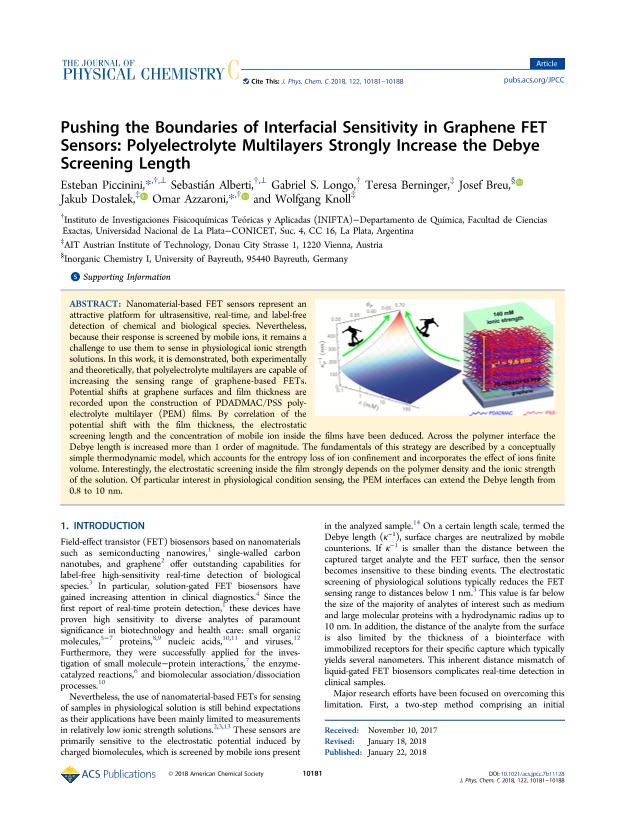Artículo
Pushing the Boundaries of Interfacial Sensitivity in Graphene FET Sensors: Polyelectrolyte Multilayers Strongly Increase the Debye Screening Length
Piccinini, Esteban ; Alberti, Sebastián
; Alberti, Sebastián ; Longo, Gabriel Sebastian
; Longo, Gabriel Sebastian ; Berninger, Teresa; Breu, Josef; Dostalek, Jakub; Azzaroni, Omar
; Berninger, Teresa; Breu, Josef; Dostalek, Jakub; Azzaroni, Omar ; Knoll, Wolfgang
; Knoll, Wolfgang
 ; Alberti, Sebastián
; Alberti, Sebastián ; Longo, Gabriel Sebastian
; Longo, Gabriel Sebastian ; Berninger, Teresa; Breu, Josef; Dostalek, Jakub; Azzaroni, Omar
; Berninger, Teresa; Breu, Josef; Dostalek, Jakub; Azzaroni, Omar ; Knoll, Wolfgang
; Knoll, Wolfgang
Fecha de publicación:
05/2018
Editorial:
American Chemical Society
Revista:
Journal of Physical Chemistry C
ISSN:
1932-7447
Idioma:
Inglés
Tipo de recurso:
Artículo publicado
Clasificación temática:
Resumen
Nanomaterial-based FET sensors represent an attractive platform for ultrasensitive, real-time, and label-free detection of chemical and biological species. Nevertheless, because their response is screened by mobile ions, it remains a challenge to use them to sense in physiological ionic strength solutions. In this work, it is demonstrated, both experimentally and theoretically, that polyelectrolyte multilayers are capable of increasing the sensing range of graphene-based FETs. Potential shifts at graphene surfaces and film thickness are recorded upon the construction of PDADMAC/PSS polyelectrolyte multilayer (PEM) films. By correlation of the potential shift with the film thickness, the electrostatic screening length and the concentration of mobile ion inside the films have been deduced. Across the polymer interface the Debye length is increased more than 1 order of magnitude. The fundamentals of this strategy are described by a conceptually simple thermodynamic model, which accounts for the entropy loss of ion confinement and incorporates the effect of ions finite volume. Interestingly, the electrostatic screening inside the film strongly depends on the polymer density and the ionic strength of the solution. Of particular interest in physiological condition sensing, the PEM interfaces can extend the Debye length from 0.8 to 10 nm.
Palabras clave:
FET SENSORS
,
POLYELECTROLYTE MULTILAYER
,
DEBYE LENGTH
,
THERMODYNAMIC MODEL
Archivos asociados
Licencia
Identificadores
Colecciones
Articulos(INIFTA)
Articulos de INST.DE INV.FISICOQUIMICAS TEORICAS Y APLIC.
Articulos de INST.DE INV.FISICOQUIMICAS TEORICAS Y APLIC.
Citación
Piccinini, Esteban; Alberti, Sebastián; Longo, Gabriel Sebastian; Berninger, Teresa; Breu, Josef; et al.; Pushing the Boundaries of Interfacial Sensitivity in Graphene FET Sensors: Polyelectrolyte Multilayers Strongly Increase the Debye Screening Length; American Chemical Society; Journal of Physical Chemistry C; 122; 18; 5-2018; 10181-10188
Compartir
Altmétricas



